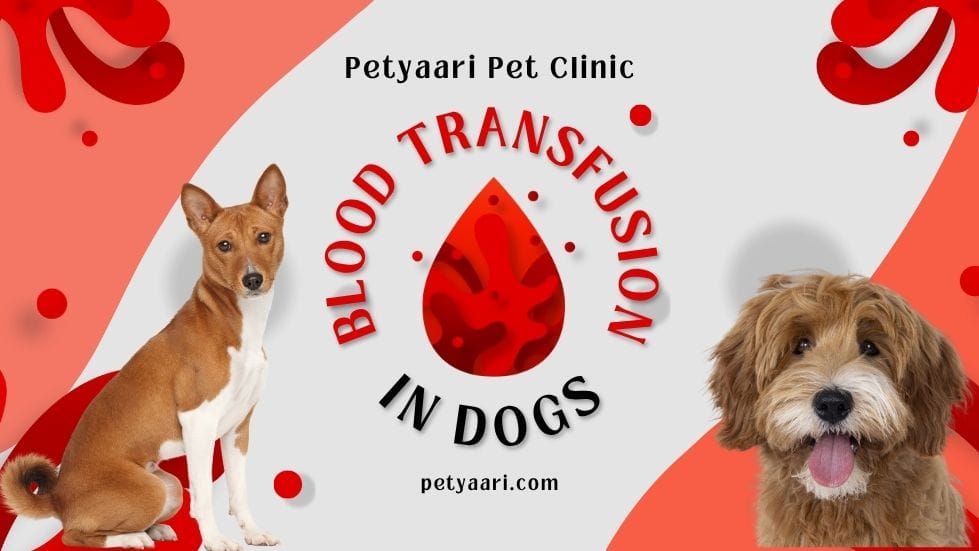A blood transfusion can be a vital lifeline for your dog in critical situations like tick fever, traumatic blood loss, or autoimmune diseases. Be alert for signs like pale gums, weakness, or rapid breathing. Acting quickly can make a big difference. With the right treatment, most dogs can recover fully. Dogs have over 12 blood types. This makes precise matching crucial to avoid dangerous reactions. In emergencies, every drop of blood truly counts. This guide provides key information about blood types, procedures, costs, and associated risks. It helps you support your pet’s recovery with confidence.
If your dog has tick-borne illnesses like Ehrlichia or Babesia, is recovering from surgery, or battling IMHA, our transfusion service is here to help. We combine cutting-edge veterinary haematology with compassionate care. At Petyaari Pet Clinic, we specialise in emergency canine transfusions. We use advanced blood typing and crossmatching to ensure safe and compatible donations from our screened canine blood bank. Trust Petyaari to provide the expert care your pet needs when it matters most.
Why Dogs Need Blood Transfusions
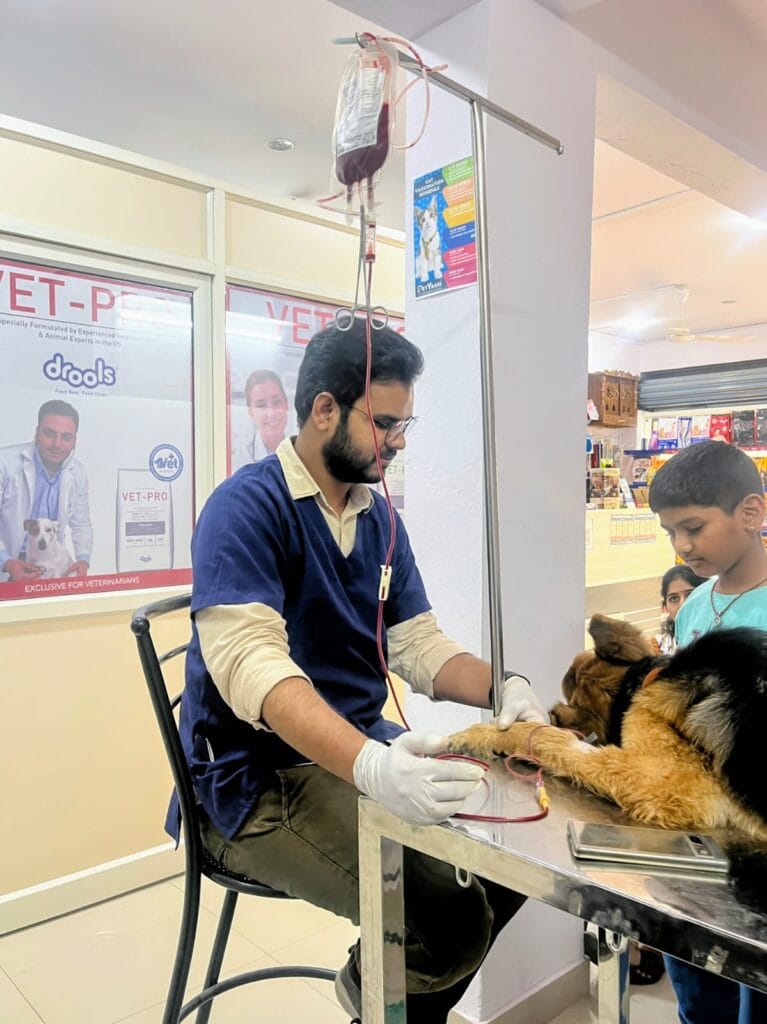
Blood transfusions are needed for dogs with severe blood loss, anaemia, or clotting issues. Transfusions help restore red blood cells, platelets, and plasma proteins. They stabilise your dog until the main problem can be treated. Petyaari’s skilled vets check each case to see if a transfusion is needed.
Common Conditions Requiring Transfusions
- Anaemia from Tick-Borne Diseases: Ehrlichiosis and Babesiosis are caused by parasites of the genera Ehrlichia and Babesia. These parasites destroy red blood cells.
- Worm Infestations: Hookworms and ascariasis can lead to severe anaemia, especially in puppies.
- Trauma or Injury: External injuries or internal bleeding, like hemoabdomen, lead to significant blood loss.
- Immune-Mediated Hemolytic Anaemia (IMHA): The immune system attacks red blood cells, requiring urgent transfusions.
- Disseminated Intravascular Coagulation (DIC): A clotting disorder that consumes platelets and proteins.
- Major Surgery: Blood loss during complex procedures, such as tumor removal, may require transfusions.
- Bleeding Disorders: Conditions like haemophilia impair clotting, requiring plasma or whole blood.
- Chronic Kidney Disease (CKD): Reduces red blood cell production, leading to chronic anaemia.
- Cancer: Bone marrow cancers, like lymphoma, can suppress blood cell production.
- Postpartum Bleeding: Female dogs may experience severe bleeding after giving birth.
Signs Your Dog May Need a Transfusion
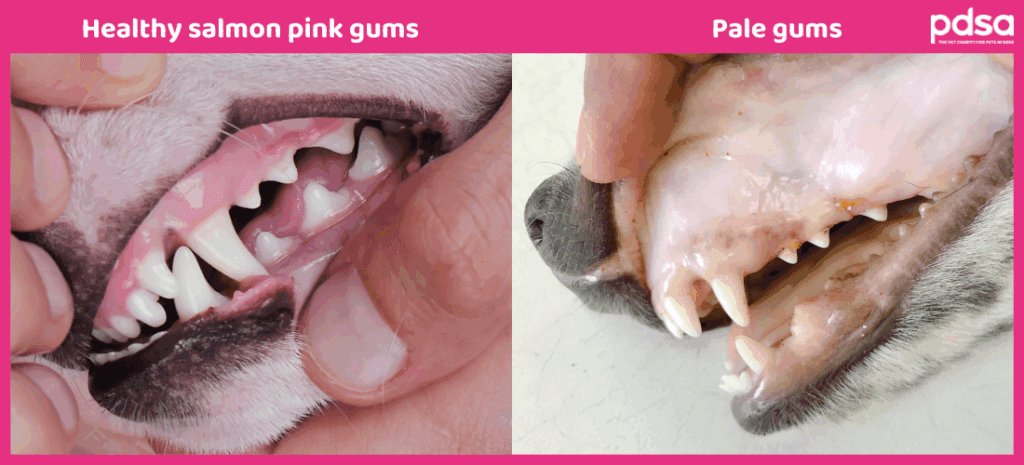
Signs that may show a need for a transfusion are:
- Pale or yellow gums
- Lethargy
- Rapid breathing
- Weakness
- Bruising
- Petechiae (small red spots on the skin)
If you see these signs, contact Petyaari right away. They will conduct a comprehensive evaluation, including blood tests to assess your red blood cell and platelet counts.
Emergency Nature of Transfusions
Blood transfusions are often an emergency procedure to stabilise a dog. Veterinarians should diagnose and treat the root cause, such as infections, parasites, or trauma. At Petyaari, we understand the urgency. We quickly respond and offer a blood transfusion. We work hard to treat your pet’s underlying issues with great compassion.
Understanding Canine Blood Types
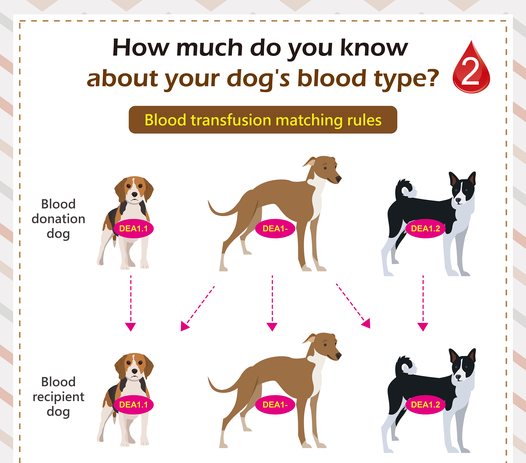
Dogs have a more complex blood typing system than humans. They have over 12 distinct blood types, whereas humans have only four types: A, B, AB, and O. Proper blood matching is crucial to avoid severe reactions. Petyaari uses advanced testing to confirm compatibility.
Do Dogs Have the Same Blood Types as Humans?
No, canine blood types are unique and unrelated to human ABO groups. Dogs rely on the DEA system, making human-dog transfusions impossible.
How Many Blood Types Do Dogs Have?
Dogs have over 12 blood types, with DEA 1 being the most critical for transfusions.
The DEA System
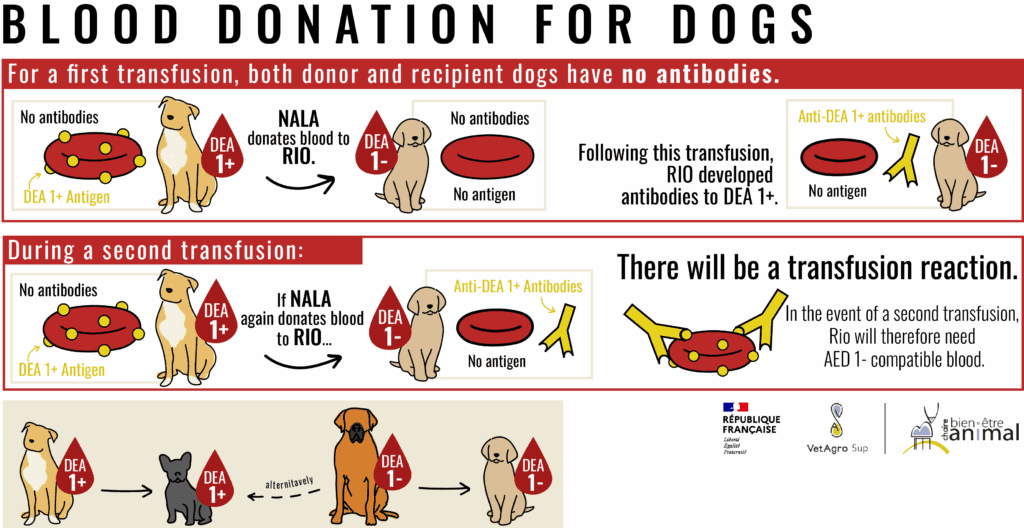
The Dog Erythrocyte Antigen (DEA) system classifies canine blood types. In the DEA system, DEA 1 is the most important. It is classified as either positive or negative. While other types, such as DEA 3, 4, 5, and 7, exist, they are less likely to cause transfusion reactions. Testing for DEA 6 and 8 is no longer available because of limitations in the reagents.
The Dal Antigen
The Dal antigen appears in some mixed breeds, as well as in Labrador Retrievers, Golden Retrievers, and Beagles. Its presence can impact transfusion compatibility. Petyaari checks for it to ensure safe matches when needed.
Blood Typing Methods
Petyaari employs several blood typing tests to identify DEA 1 and other antigens:
- Card Agglutination Test (RapidVet-H): This is a fast test done in the clinic. It mixes blood and a reagent on a card. Clumping indicates DEA 1-positive blood but may yield false positives in IMHA cases.
- Immunochromatographic Strip Test: This test is very accurate. It shows a line if DEA 1 is present, which reduces false positives.
- Gel Column Agglutination: This method uses a gel matrix to find clumping. It needs a centrifuge but gives precise results.
- Laboratory Typing: This method is rare. It’s used for uncommon antigens, such as DEA 3, 4, 5, and 7. Research labs handle it, but it’s not practical for emergencies because of delays.
Crossmatching
Crossmatch testing ensures the safety of blood transfusions in dogs by detecting antibodies that could cause hemolytic reactions. In dogs, crossmatching isn’t needed for the first transfusion. However, for later transfusions, it’s required due to the possibility of sensitisation. Crossmatching is important because dogs can develop antibodies to foreign antigens, such as DEA 1, within four days of a transfusion. Three types of crossmatches are performed:
- Major Crossmatch: This test checks the recipient’s serum with donor red blood cells. It helps find any recipient antibodies.
- Minor Crossmatch: This test checks the donor serum with the recipient’s red blood cells. It helps find any donor antibodies.
- Autocontrol: It tests the recipient’s serum using their red blood cells. This checks for autoimmune reactions.
The Blood Transfusion Process
The transfusion process is a carefully managed procedure to ensure safety and efficacy. Petyaari follows strict protocols, from donor selection to post-transfusion monitoring.
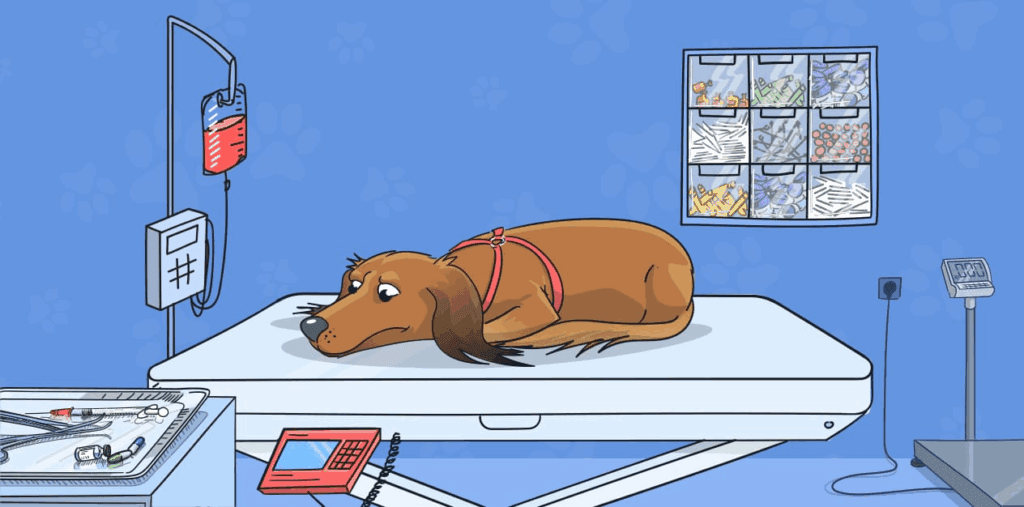
Steps in the Transfusion Process
- Finding a Donor: The Donor should be at least 25 kg, healthy, and not obese. Donors must be fully vaccinated, dewormed, and free from infections such as Ehrlichia, Babesia, or Anaplasma. They should also have no heart, kidney, or liver disease.
- Blood Typing and Crossmatching: Ensures compatibility, especially for DEA 1, to prevent reactions.
- Blood Collection: Donor blood is collected in anticoagulant bags to prevent clotting.
- Administration: Blood (whole, red cells, or plasma) goes through an IV line with a filter. It’s usually given over two to four hours, depending on the dog’s weight and the amount of blood it has lost.
- Monitoring: Veterinarians continuously monitor heart rate, breathing, and temperature for signs of a reaction.
Are Transfusions Safe for Older Dogs?
Yes, blood transfusion is safe in older dog, if its’s health is stable. Petyaari evaluates senior dogs to ensure safety.
Types of Transfusions
- Whole Blood: Provides red cells, plasma, and clotting factors for severe blood loss or anaemia.
- Packed Red Blood Cells: Used for anaemia, delivering oxygen-carrying cells without excess fluid.
- Plasma Transfusions: Supplies clotting factors and proteins for disorders like DIC or poisoning.
Where does dog blood transfusion come from?
The Blood for dog blood transfusion comes from a donor dog or blood banks. Due to the low number of dog blood banks in India, we need to find a donor dog. Fresh Blood is taken from a donor dog, checked for compatibility, and then transfused to the recipient.
Can dogs get blood transfusions from humans
No, Dogs cannot get blood transfusions from humans. Human blood is not suitable for transfusion, adverse reactions can be seen when transfused. It can also lead to death of dog. Dogs have their own unique blood types, and transfusions must come from another dog with a compatible blood type.
Can a cat receive a blood transfusion from a dog
No, a cat should not receive a blood transfusion from a dog. The cat’s immune system will usually recognize the dog blood as foreign and destroy it within a few days, potentially causing severe reactions.
Who Can Be a Donor?
Ideal donors meet these criteria:
- Age: One to six years old.
- Weight: At least 25 kg, healthy, and not obese.
- Health: Fully vaccinated, dewormed, free of infections (e.g., Ehrlichia, Babesia, Anaplasma), and no heart, kidney, or liver disease.
- Medications: Not on long-term drugs.
- Temperament: Calm, able to sit for 20 minutes during collection.
- Blood Type: Ideally, DEA 1 negative (universal donor), but DEA 1 positive is okay for positive recipients.
In emergencies, any healthy dog can theoretically donate, but a DEA-1 negative blood is preferred to minimise reaction risks.
Dog Blood Transfusion Survival Rates
The success of a transfusion depends on the underlying condition, the dog’s health, and timely intervention. Petyaari’s expertise maximises positive outcomes.
Are Blood Transfusions in Dogs Successful?
Yes, blood transfusions in dogs are often very successful, especially when performed under proper veterinary care. The first transfusion is usually highly successful, with minimal risk if blood type and compatibility are properly checked. Most dogs respond quickly and positively to a transfusion. Risks and complications tend to rise with repeat transfusions, but they can still be successful with proper matching and monitoring.
Survival Rates by Condition for Transfusion
- Hemoabdomen: 40-60%, depending on the cause (e.g., ruptured spleen) and treatment speed.
- IMHA: 50-70% with transfusions and immunosuppressive therapy.
- Tick-Borne Diseases: Up to 80% of healthy dogs receive one-time emergency transfusions.
- Plasma Transfusions: Often exceed 80% for clotting disorders when promptly administered.
Factors Affecting Outcomes
Older dogs, those with co-existing conditions, or severe trauma may have lower survival rates. Petyaari tailors treatment to improve recovery chances.
How long does a blood transfusion last in a dog?
Transfused red blood cells last 110-120 days if sourced directly from a donor. Blood bank storage can shorten the lifespan of blood. However, approximately 70% of donor red cells remain functional for 110 days if there is no ongoing blood loss. Dogs with conditions like IMHA or parasites may need repeated transfusions.
Risks and Side Effects
While transfusions are generally safe, risks exist. Petyaari’s rigorous screening and monitoring minimise complications.
Potential Transfusion Reactions
- Acute hemolytic reactions occur when a person receives the wrong blood type. For example, a DEA 1 negative recipient might receive DEA 1 positive blood. This mismatch destroys red blood cells.
- Allergic Reactions: Symptoms include fever, rashes, hives, itching, or skin irritation. These can be managed with antihistamines or steroids.
- Infections: Rare due to donor screening and sterile techniques.
Signs of a reaction after blood transfusion in dogs include rapid breathing, rapid heart rate, vomiting, diarrhoea, or collapse. Petyaari watches dogs for at least 24 hours after a transfusion. If needed, we give emergency medications.
Side Effects
Common side effects, distinct from reactions, include:
- Mild fever or shivering.
- Temporary lethargy or tiredness.
- Slight increase in heart or breathing rate.
- Nausea or loss of appetite.
- Swelling of the face or limbs.
- Pale or yellow gums (in severe cases).
These are typically mild and resolve quickly. Pet owners might see similar side effects and reactions. But Petyaari’s team helps you know what to look out for.
Cost of Blood Transfusion in Dogs
The cost of a blood transfusion for dogs in India varies depending on the location, facility, and level of care complexity. Petyaari offers transparent pricing to ease financial planning.
How much does a blood transfusion cost for a dog?
The average blood transfusion cost for a dog can vary depending on several factors. A single transfusion session typically ranges from ₹5,000 to ₹15,000, influenced by the volume and type of blood required. Prior to the transfusion, blood typing and cross-matching are necessary procedures, which can cost between ₹1,000 and ₹3,000. In addition to these core expenses, patients may incur further charges for hospitalisation, diagnostic tests, and medications, which can add another ₹2,000 to ₹10,000 to the overall bill.
Regional Variations
Costs in cities like Bangalore, Mumbai, and Hyderabad may be higher due to the availability of advanced facilities and infrastructure. Contact Petyaari for a precise estimate tailored to your dog’s needs.
Frequently Asked Questions
Can Dogs Get Blood Transfusions?
Yes, dogs can safely receive transfusions for anaemia, blood loss, or clotting disorders with proper blood typing.
How Successful Are Transfusions?
Transfusions are highly successful when blood types match, with a survival rate of up to 80% for one-time emergency cases. Treating the underlying cause is essential to avoid repeated transfusions.
How Much Blood Can a Dog Lose?
Dogs can lose 15-20% of their blood volume (10-15 mL/kg) without immediate danger to their health. There is a greater risk of shock or organ failure, necessitating a transfusion.
How Many Blood Transfusions Can a Dog Have?
There is no limit to how many blood transfusions a dog can receive over its lifetime, as long as proper crossmatch test and compatibility are followed. However, multiple transfusions, the risk of delayed hemolytic reactions or transfusion-related complications rises. Repeated transfusions need to be spaced out over time.
Is blood transfusion painful for dogs?
No, a blood transfusion is not painful for dogs. The process is similar to receiving IV fluids and involves placing a catheter in a vein. Some mild discomfort may occur when the needle is inserted, but the transfusion itself is gentle and painless. Dogs are usually relaxed, often lying down or resting during the procedure. Sedation is rarely needed unless the dog is very anxious or unwell.
Why Choose Petyaari?
Petyaari is your trusted partner for canine blood transfusions in India, offering:
- Expertise: Skilled veterinarians trained in transfusion medicine.
- Safety: Advanced crossmatching and donor screening.
- Accessibility: Services in Hyderabad with transparent pricing.
- Compassion: Personalised care to support you and your pet.
- Blood Bank: Reliable supply of safe, high-quality blood.
When your beloved dog’s life is in an emergency, choosing the right clinic is paramount. Trust Petyaari for expert and safe blood transfusion services. We combine professionalism, top veterinary skills, and strong empathy to save lives. Contact us today to schedule a consultation or learn more about how we can support your pet’s health and recovery.
